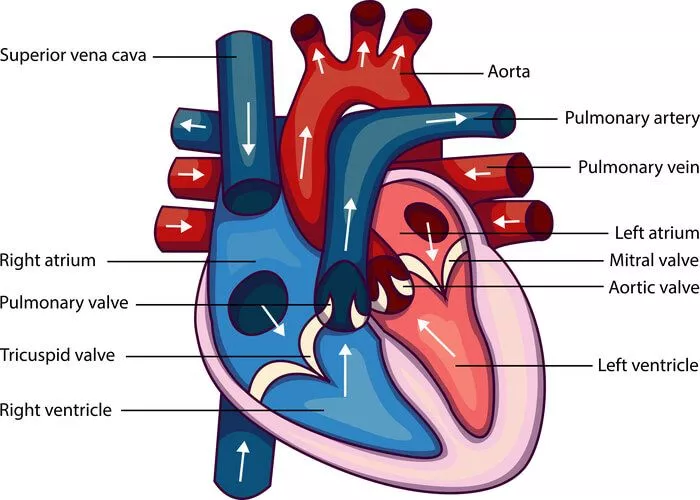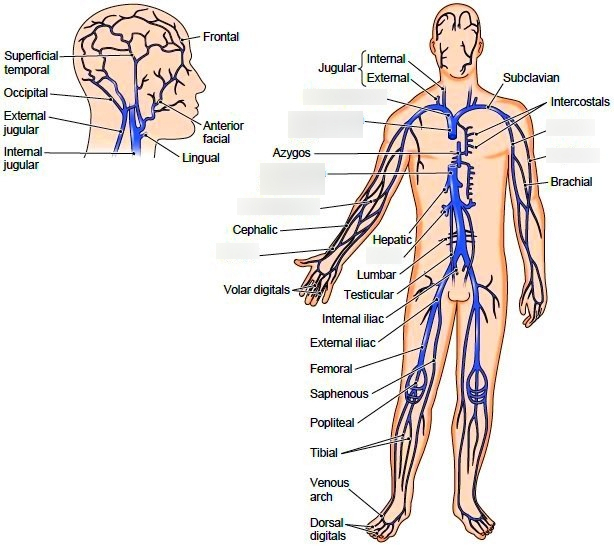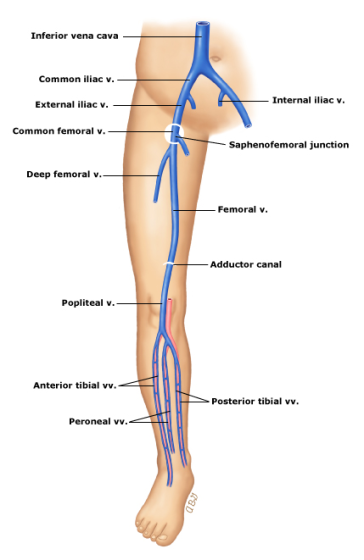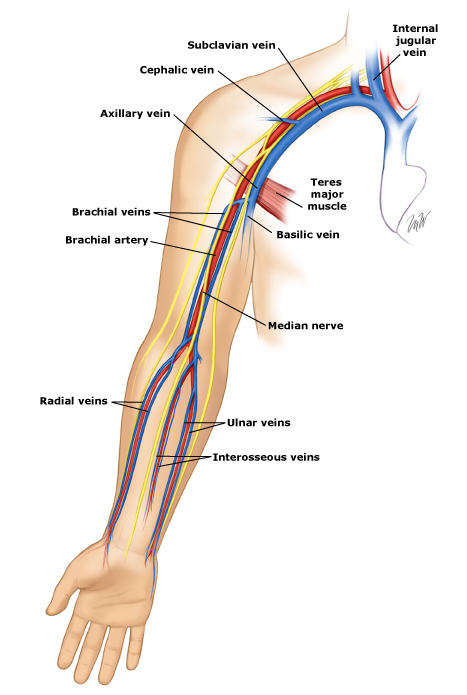When it comes to the human body, Blood Vessels are a crucial part of the Circulatory System. Among these Vessels, Veins are especially important as they carry blood back to the Heart from various organs and tissues.
Veins work together with Arteries which carry oxygen-rich blood away from the heart and into the body’s tissues. Veins on the other hand transport oxygen-depleted blood back to the Heart where it’s then sent to the lungs to be re-oxygenated. It’s a constant cycle that’s essential for keeping us alive and healthy.
But the importance of Veins goes beyond simply moving blood around the body. They also play a vital role in preventing health issues such as blood clots, edema, and varicose veins. Without properly functioning Veins blood flow could become inefficient leading to serious health problems.
In this article we’ll dive into the different types of Veins found in the human body and their unique characteristics.
There are four main types of veins to cover –
- Superficial Veins
- Deep Veins
- Pulmonary Veins
- Systemic Veins.
Understanding the various types of veins and their functions is crucial to maintaining good health and preventing potential cardiovascular issues. So, let’s get started!
Also Check – Veins – Structure , functions ,Venous System and Circuits and Vein Valves
Table of Contents
4 Main types Types of Veins
Veins can be categorized into four main types –
- Superficial Veins
- Deep Veins
- Pulmonary Veins
- Systemic Veins.
Each type of Vein plays an essential role in the Circulatory System.
Also Check – 8 Structural and Functional Difference Between Arteries Veins and Capillaries
Pulmonary Veins

Structure
- Pulmonary Veins are Blood Vessels that carry oxygenated Blood from the lungs to the left atrium of the Heart.
- There are four pulmonary veins in the human body – two from each lung.
- The two from the left lung are the left superior pulmonary vein and the left inferior pulmonary vein and the two from the right lung are the right superior pulmonary vein and the right inferior pulmonary vein.
- These Veins are unique in that they are the only Veins in the body that carry oxygenated Blood. They have a thin, delicate wall composed of three layers: the tunica intima, the tunica media and the tunica adventitia.
Function
- The function of Pulmonary Veins is to transport oxygenated Blood from the lungs back to the Heart specifically to the left atrium.
- From there the oxygenated Blood is pumped into the Systemic circulation, supplying the body’s tissues and organs with oxygen.
Location
- The Pulmonary Veins are located in the lungs where they receive oxygenated Blood from the capillary beds that surround the alveoli.
- The Pulmonary Veins exit the lungs and merge together to form two larger vessels, the right and left Pulmonary Veins. These Veins then enter the left atrium of the Heart, completing the Pulmonary circuit.
Also Check – 15 Important Differences Between Arteries and Veins
Systemic Veins

Structure
- Systemic Veins are Blood Vessels that carry deoxygenated Blood from the body’s tissues and organs back to the Heart.
- These Veins have a relatively thin wall compared to arteries and are composed of three layers – the tunica intima, the tunica media and the tunica adventitia.
- Systemic Veins have one-way valves that help prevent the backflow of Blood.
Function
- The function of Systemic Veins is to return oxygen-depleted Blood from the body’s tissues and organs back to the Heart.
- This deoxygenated Blood is then pumped to the lungs, where it is oxygenated and returned to the Heart.
- Systemic Veins also play an essential role in carrying waste products, such as carbon dioxide and metabolic byproducts, from the body’s tissues and organs to the lungs and kidneys for removal.
Location
- Systemic Veins are found throughout the body and are often located in close proximity to corresponding arteries.
- For example the femoral Vein runs alongside the femoral artery in the thigh and the jugular Vein runs alongside the jugular artery in the neck.
- Systemic Veins also include the superior and inferior vena cavae, which are the largest Veins in the body and return Blood to the Heart from the upper and lower body, respectively.
Also Check – Arteries in The Body
Also Check – Arteries – Structure , Layers, Functions
Superficial Veins

Structure
- Superficial Veins are located near the surface of the skin and are typically smaller in diameter than Deep Veins.
- They are composed of three layers, including the tunica intima, the tunica media and the tunica adventitia.
- Unlike Deep Veins Superficial Veins do not typically run alongside corresponding arteries and they are often connected to Deep Veins via perforating Veins.
- In smaller Superficial Veins, valves may be present to prevent backflow of Blood.
Function
- The function of Superficial Veins is to transport deoxygenated Blood from the body’s tissues back to the Heart.
- Since they are located near the surface of the skin, they are more visible and can be used for medical procedures such as Blood draws or IV insertions.
Location
- Superficial Veins are found throughout the body, including the arms, legs and neck. Examples of Superficial Veins include the cephalic Vein in the arm, the great saphenous Vein in the leg and the external jugular Vein in the neck.
Recent studies have shown that venous valves may be present in small Superficial Veins, including those with a luminal diameter of less than 100 micrometers. In one study vascular casts were made from six adult lower limbs and viewed using scanning electron microscopy. The study found that 94% of the valves identified were in Veins less than 300 micron in luminal diameter, with 65% of the valves present in venous channels less than 100 microm in luminal diameter. The smallest valves identified were present in venous channels with a diameter of 18 micrometers. These valves were bicuspid and often associated with a tributary.
Also Check – Why is it necessary to separate Oxygenated and Deoxygenated Blood
Deep Veins


Structure
- Deep Veins are larger in diameter than Superficial Veins and have thicker walls.
- The walls of the Deep Veins contain smooth muscle cells which allow them to contract and push Blood back toward the Heart.
- The Deep Veins also have valves, which prevent backflow of Blood and ensure that Blood flows only in one direction.
Function
- Deep Veins are responsible for carrying deoxygenated Blood from the peripheral tissues and organs of the body back to the Heart.
- They play a crucial role in maintaining proper Blood circulation and are responsible for returning a large volume of Blood to the Heart.
- The Deep Veins also work in conjunction with the skeletal muscles to facilitate the venous return of Blood.
- The skeletal muscles contract and relax, squeezing the Veins and helping to propel Blood back toward the Heart.
- The valves in the Deep Veins prevent Blood from flowing backward and help maintain the unidirectional flow of Blood.
Location
- Deep Veins are located deep within the muscle tissue and are typically located alongside the corresponding arteries. For example, the femoral Vein is located deep within the muscles of the thigh and runs parallel to the femoral artery.
- The Deep Veins of the lower extremities are responsible for returning Blood from the legs and feet, while the Deep Veins of the upper extremities are responsible for returning Blood from the arms and hands.
Also Check – Why Do Arteries Have Thick Elastic Walls ?
Similarities and Differences between the Four Main types of Veins
Similarities between Superficial Veins , Deep Veins, Pulmonary Veins and Systemic Veins
- All types of Veins are responsible for carrying Blood in the Circulatory System.
- All Veins have a thin layer of smooth muscle in their walls to help with Blood flow.
- All Veins have one-way valves that prevent backflow of Blood and ensure that Blood flows only in one direction.
- All Veins have endothelial cells lining their walls.
Differences between Superficial Veins , Deep Veins, Pulmonary Veins and Systemic Veins
- Pulmonary Veins carry oxygenated Blood from the lungs to the Heart while Systemic Veins carry deoxygenated Blood from the body to the Heart.
- Superficial Veins are located close to the surface of the skin and are not located near a corresponding artery while Deep Veins are located deep within muscle tissue and are typically located near a corresponding artery with the same name.
- Systemic Veins and Pulmonary Veins have thinner walls than Deep Veins, as they do not need to withstand as much pressure.
- Superficial Veins have valves that prevent backflow of Blood, but it was previously believed that these valves were not present in Veins smaller than 2mm in diameter. However, recent studies have identified venous valves in small Superficial Veins as well.
- Deep Veins are responsible for carrying a larger volume of Blood than Superficial Veins, as they are responsible for returning Blood from the peripheral tissues and organs of the body back to the Heart.
- The endothelial cells in the walls of Deep Veins are larger and more numerous than those in Superficial Veins, as the Deep Veins have to withstand greater pressure.
Frequently asked Curious Questions on Types of Veins and their Functions
What are the main functions of veins in the circulatory system?
Veins carry blood back to the heart from various organs and tissues. They transport oxygen-depleted blood to the heart, where it’s sent to the lungs to be re-oxygenated.
Why do pulmonary veins carry oxygenated blood, unlike other veins?
Pulmonary veins carry oxygenated blood from the lungs to the heart because they transport blood that has just been oxygenated in the lungs, making them unique among veins.
How do systemic veins differ from pulmonary veins?
Systemic veins carry deoxygenated blood from the body’s tissues and organs back to the heart, while pulmonary veins carry oxygenated blood from the lungs to the heart.
What are superficial veins, and where are they located?
Superficial veins are located near the surface of the skin, typically smaller in diameter than deep veins, and visible through the skin. They transport deoxygenated blood back to the heart.
How do deep veins support the circulatory system?
Deep veins, which are larger and have thicker walls than superficial veins, carry deoxygenated blood from peripheral tissues back to the heart. They work with skeletal muscles to facilitate blood return.
Can valves be found in all types of veins?
Yes, all veins have one-way valves to prevent backflow of blood and ensure unidirectional flow.
Why are the walls of deep veins thicker than those of other veins?
Deep veins have thicker walls to withstand greater pressure as they are responsible for returning a large volume of blood to the heart from peripheral tissues.
Are all veins located alongside arteries?
Not all veins. While deep veins typically run alongside corresponding arteries, superficial veins do not usually have corresponding arteries nearby.
What role do valves play in superficial veins?
Valves in superficial veins prevent backflow of blood, and recent studies have shown that even small superficial veins can have valves.
How do pulmonary veins contribute to the oxygenation of blood?
After oxygenation in the lungs, pulmonary veins transport the oxygen-rich blood back to the heart, which then pumps it throughout the body.
Do veins only carry deoxygenated blood?
Mostly, except for pulmonary veins which carry oxygenated blood from the lungs to the heart.
Can veins be used for medical procedures?
Yes, superficial veins, being more visible and near the surface, are often used for blood draws and IV insertions.
Why do systemic veins have thinner walls compared to deep veins?
Systemic veins have thinner walls as they do not need to withstand as much pressure as deep veins.
What happens to blood in the veins when muscles contract?
When muscles contract, they squeeze the deep veins, helping propel blood back toward the heart. Valves in these veins prevent blood from flowing backward.
Why is it important for veins to have smooth muscle in their walls?
The smooth muscle helps with blood flow by contracting and relaxing, aiding in the movement of blood through the veins.
Are there differences in endothelial cells among different types of veins?
Yes, the endothelial cells in deep veins are larger and more numerous than those in superficial veins, as deep veins must withstand greater pressure.
How do veins adapt to different pressures in the body?
Veins adapt through their structure: deep veins have thicker walls for higher pressure, while superficial and systemic veins have thinner walls for lower pressure situations.
